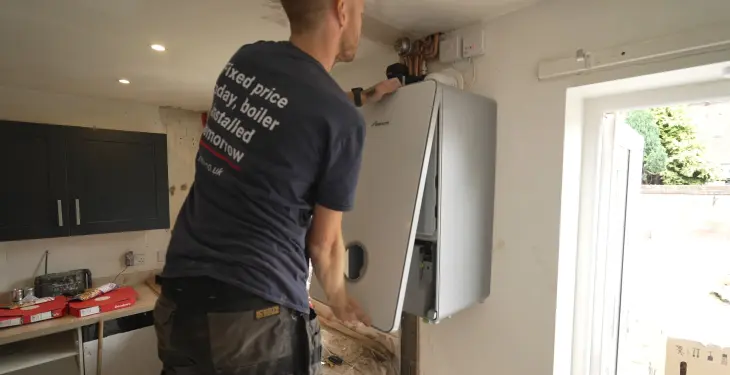

Written by Stephen Day
Gas Safe Engineer
Updated: 30th May, 2025
While it seems logical that using less heating could save money, the effectiveness of this strategy can depend on several factors, including the type of boiler in use and the layout of the heating system.
Get a new boiler quote, save up to £550 per year (0% APR available).
Is turning down radiators in unused rooms a smart way to save on energy bills, or could it have the opposite effect? This is a question many homeowners grapple with, especially as heating costs rise. While it seems logical that using less heating could save money, the effectiveness of this strategy can depend on several factors, including the type of boiler in use and the layout of the heating system.
Turning off radiators in empty rooms might not always be the best approach to saving on energy costs. When radiators are shut off, it can disrupt the efficiency of the entire heating system, particularly in homes with modern condensing boilers. These systems are designed to run more efficiently at certain temperatures and may not perform as well if individual radiators are turned off unnecessarily.
For those using electric radiators or heat pumps, the strategy may vary slightly. Each type of heating system has its own nuances that can affect the best practices for energy conservation. Exploring how these systems interact with room thermostats and boiler settings can uncover surprising insights into achieving optimal energy savings.
Get a quote in 60 seconds, fitted as fast as next day!
0% APR finance available.
When rooms are not in use, it may seem wise to turn off the radiators. This can be a simple way to try and cut down on energy use and lower heating costs.
In many homes, thermostatic radiator valves (TRVs) can be found on radiators. These valves allow people to adjust the heat level or turn off the radiator altogether. Using TRVs to control heating in unused rooms ensures less energy is wasted in these spaces.
With older boiler systems, turning off unused radiators can indeed save gas and reduce bills. These systems are less efficient, and shutting off radiators directs heat to where it is most needed.
However, in modern homes with energy-efficient condensing boilers, the effect may differ. These boilers are designed to work efficiently under specific conditions. Closing too many radiators might actually make them less efficient, as the boiler may not condense effectively.
There are also potential risks, like increased dampness in colder, unheated rooms. This can be damaging over time, particularly in areas prone to condensation. Balancing warmth across the home is essential to mitigate this issue.
It's advisable to keep a low setting on TRVs in unoccupied rooms, rather than turning them off entirely. This approach can help avoid excessive cold spots and maintain a stable environment, both for comfort and the health of the building.
Ultimately, the strategy of turning off radiators in empty rooms depends on several factors, including the heating system type and the specific needs of the household. Consideration of these aspects will help determine the best approach for managing heating costs effectively.
Turning off radiators in unused rooms might seem like a smart way to save on energy bills. But it can sometimes lead to unexpected costs.
Modern condensing boilers, for example, work best when cooler water returns to the system. When radiators are turned off, it might cause the boiler to stop condensing effectively, resulting in less efficient operation.
Older, non-condensing boilers also present challenges. Turning off multiple radiators can lead to increased pressure on the system. This might cause wear or damage over time, leading to costly repairs.
With a condensing boiler, maximising efficiency means ensuring heat loss as water returns to it. Turning radiators off reduces this heat loss, making the boiler less efficient. The boiler may then use more gas to achieve the desired temperature.
For homes with a gas boiler, turning off too many radiators might push it to work harder to maintain set temperatures. This extra workload can increase energy consumption rather than decrease it.
A balanced approach is key. Instead of shutting off radiators completely, consider lowering the settings. This helps maintain overall efficiency and keeps costs in check.
Ensuring that all rooms are heated, even if slightly, can also reduce the risk of damp and condensation, which can be costly to fix. This makes managing radiator use thoughtfully a better strategy than just turning them off.
Using every radiator can actually help manage heating bills more effectively. By engaging the entire central heating system, homes can achieve a balanced and efficient temperature.
When each radiator is used, the central heating system doesn't need to overcompensate in certain areas, avoiding unnecessary energy use.
Benefits include:
Consistent Room Temperatures: Every room gets the warmth it needs without creating hot or cold spots.
Efficient Energy Use: Spreading the heat evenly means the system works less hard, saving gas and reducing bills.
Avoids Pipe Freezing: Keeping radiators on low prevents pipes from freezing in empty rooms during the winter months.
Using all radiators with a lower flow temperature can also be key. Lowering the flow temperature makes the heating system more efficient, consuming less energy over time.
Example Settings:
Room Type | Recommended Radiator Setting |
Living Room | Medium |
Bedroom | Low |
Unused Rooms | Low or Off |
Adjust the settings according to usage and comfort. Thermostatic radiator valves (TRVs) can help manage room-by-room temperature, providing balance and saving energy.
By being mindful of heating system settings, households effectively tackle high heating bills and maintain comfort throughout the home.
Setting the right boiler flow temperature can significantly cut down energy costs. The standard setup for modern boilers usually involves a flow temperature of around 80°C. This means water leaves the boiler at this temperature before circulating through the radiators.
Adjusting the flow temperature can make a boiler more efficient. Many experts suggest lowering it to around 60°C to 65°C. This not only saves money but also helps the boiler condense, making it run better. A lower flow temperature doesn’t necessarily lead to a colder home.
Using a thermostat smartly can also help. The thermostat controls the ambient air temperature, but it doesn’t change the flow temperature. If the boiler keeps the flow temperature low, the thermostat can still maintain a cosy room temperature while using less energy.
Weather compensation can further optimise this setup. Some boilers have weather compensation controls, which adjust the flow temperature based on the outside temperature. This ensures maximum efficiency, saving even more gas and money.
Here's a simple guideline:
Action | Suggested Flow Temperature |
Standard Setting | 80°C |
Recommended Setting | 60°C - 65°C |
By keeping the flow temperature in this range, households can enjoy both warmth and savings.
Setting the correct flow temperature on your boiler is key to improving energy efficiency. Most boilers are set at an 80/60 ratio, meaning water flows out at 80°C. This can be adjusted for better performance.
Steps to Adjust Flow Temperature:
Identify the Control Panel: Most boilers feature a straightforward panel with up and down buttons. Locate these to adjust the temperature.
Adjust the Flow Temperature: Lower the boiler flow temperature gradually. Aim for around 60°C. This is more efficient and can save on energy bills.
Check Radiators: Use thermostatic radiator valves to control the heat in each room. This prevents overheating any single room.
Maximise Efficiency with Thermostats:
Room Thermostat: Set to maintain overall comfort. It stops the boiler from heating the water when not needed.
Modulating Thermostat: Adjusts boiler output to avoid unnecessary fuel use, providing consistent temperature.
The flow temperature influences how effectively radiators heat the space. Lowering it appropriately can make your heating system more efficient.
Benefits:
Cost Savings: Even a small reduction in temperature can lead to significant savings. For example, adjusting a room thermostat correctly stops excess energy use.
Comfort: Balanced warmth with thermostatic controls ensures each room reaches desired comfort without wasting energy.
These steps can help optimise a home's heating system, contributing to both comfort and cost savings without sacrificing performance.
Keeping radiators on can help improve the efficiency of your heating system. This is mainly because allowing the radiators to stay on maintains a steady and consistent flow of heat. When the system is stable, it can distribute warmth more evenly throughout the home.
A key factor is radiator surface area. When radiators are on, this surface area helps maintain a lower flow temperature. A lower flow temperature enables the boiler to work more efficiently. By avoiding sudden bursts of heat, the overall system stays balanced.
A common setup involves keeping radiators on at a low setting. This ensures a small amount of water continues to circulate. Such circulation prevents issues like dampness and freezing. It also helps the boiler operate in a condensing mode, which is more efficient.
Radiators in unoccupied rooms can be set to a lower level rather than fully off. Turning them completely off could lead to increased energy consumption later. Reheating a cold room uses more energy than maintaining a mild ambient temperature.
Managing heat levels across the radiators uses energy wisely. Consistency in the system allows for better control over heating costs. This approach minimises unnecessary spikes in energy use, leading to a more cost-effective way to heat the home.
Heat pumps are an energy-efficient alternative to traditional boilers. They work by transferring heat from the outside air or ground into your home. A key feature of heat pumps is their lower flow temperature. Unlike conventional boilers, heat pumps typically operate at a flow temperature between 35°C and 55°C.
Using lower flow temperatures helps boost efficiency. It means the radiators may not feel as hot to touch, but they effectively warm your home over time. This efficient use of energy helps in reducing energy bills and carbon emissions.
Radiator Size:
To maintain warmth with lower flow temperatures, larger radiators are often needed. This is because they have more surface area to release heat into the room. Most homes already have radiators bigger than necessary due to industry practices, which can be beneficial when using heat pumps.
Well-insulated homes maximise the benefits of heat pumps. Proper insulation helps retain the heat inside, requiring less energy to keep rooms warm. It is crucial for maintaining comfortable indoor temperatures, especially during colder months.
Benefits:
Lower energy bills
Reduced carbon footprint
Improved efficiency
When considering a heat pump, it is important to evaluate the existing insulation. Adding or upgrading insulation can further enhance the system's performance. This combination of technology and home efficiency improvements can offer significant savings and environmental benefits.
Get a quote in 60 seconds, fitted as fast as next day!
0% APR finance available.
Last updated: 30th May, 2025

Written by Stephen Day
Gas Safe Engineer at iHeat
Stephen Day is a Gas Safe registered and FGAS certified engineer with over 20 years of hands-on experience in the heating, cooling, and renewable energy industry, specialising in boiler installations, air conditioning, and heat pump systems.
LinkedInArticles by Stephen Day are reviewed by iHeat’s technical team to ensure accuracy and reliability.

22nd December, 2025
Based on data from over 7000 boiler installations completed by iHeat in the past 12 months...
 Read Article
Read Article

22nd December, 2025
Here’s a quick roundup of the best combi boilers for 2026.
 Read Article
Read Article

22nd December, 2025
When your old boiler breaks down and it comes time to replace it with a new one, it might...
 Read Article
Read Article
No obligation. Takes less than 60 seconds.